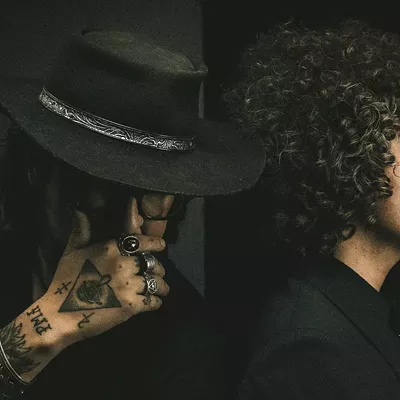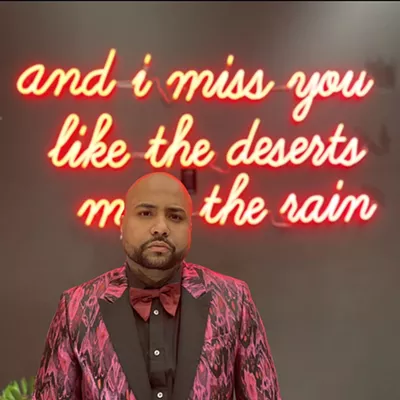When his album Night Ripper exploded in 2006, earning raves from Pitchfork and Rolling Stone, it seemed that tastes--and times--had caught up to Girl Talk.
"This is an era right now when people involved in underground music are into dancing, as opposed to 10 years ago," says Gillis.
Initially inspired by Kid 606 and Negativland, Gillis says he now listens almost exclusively to mainstream music. "When I first started listening to college radio in the '90s, it was all about Pavement, or noise, something like that. Anymore, it's just so diverse--a pop era.
"The broader idea of just embracing pop in general, and 'anything goes'--I think I definitely helped push that idea, but the seed was planted years before Night Ripper," he says.
Girl Talk's latest, Feed the Animals--released in June as a pay-what-you-want download, and out on CD on Oct. 21--is an impressive Top 40 audio collage, with 300 samples flashing past in 54 minutes. He sets rap lyrics from the likes of Ludacris, 50 Cent and Yung Joc atop pop hooks that range from the contemporary (Rihanna's "Umbrella") to yesteryear (Ace of Base's "All That She Wants"), classic rock ("Styx's "Renegade") to classics (David Bowie's "Rebel Rebel").
The album screeches off the lot with "Play Your Part (Pt. 1)," kicked off with the Spencer Davis Group's "Gimme Some Lovin'" and lyrics from UGK's "Int'l Player's Anthem": "My bitch a choosy lover, never fuck without a rubber / Never in the sheets, like it on top of the cover." It's like Girl Talk has brought out what young Steve Winwood's id was really trying to say. Multiply that little heat exchange by 150, and you get an idea of Feed the Animals' scope and density.
To create one minute of this collage takes Gillis an entire day's work: First, he comes up with a rough idea of the musical effect he's after, then digs through the massive archive of samples he's slowly accumulated over the years in search of the right ingredients. Then begins a painstaking process: Hunched over his laptop, he edits the samples using a number of programs, arranging them by trial and error. Eventually, something clicks into place, and he has a new chunk of music to play live at that weekend's show. If the crowd seems to like it, chances are good it'll turn up on the next record.
"The ultimate goal is to recontextualize the material enough where it has its own identity," he says. "The whole idea of the project is just embracing pop. I want to make the most over-the-top, pop-collage album."
But Gillis' samples are entirely unauthorized, which means his album could also be a collection of 300 potential copyright-infringement lawsuits; prominent entertainment law attorney Howard Hertz has estimated Girl Talk's maximum liability for Feed the Animals at a cool $45 million. Gillis and his label, Illegal Art, contend that by using the snippets in such unorthodox ways, he is creating new material, protected under the "fair use" legal umbrella. They haven't had to argue that case in court--so far--and some of the artists, such as Faith No More's Mike Patton, seem pleased to be included in the album.
But some of the artists Girl Talk samples are famously litigious, such as Metallica. The band demonstrated its willingness to sue in 2000, when its lawsuit against Napster effectively shut the Web site down.
"If you were gonna pick five artists that you may think would have an issue with this," Gillis says, "then there are probably three or four of those that will be on the album."
In any case, Illegal Art owner Philo T. Farnsworth (a pseudonym) thinks the industry is too occupied with illegal file sharing to bother coming after Girl Talk. "They have a much clearer case against people who are file sharing and copying things than something that's solved in a more legal grey area," he says. "Sampling was a battle they seemed more engaged in, (back) in the 1990s, but the battle for this decade has been downloading."
Gillis says he's tired of the media characterizing his music as a "lawsuit waiting to happen," yet he admits: "There's definitely a component there of seeming like an outlaw, and I think that appeals to some people." Girl Talk's appeal, perhaps, speaks to the preoccupations of a new generation raised online--and he may be just the sort of celebrity it fosters.
According to pop-culture theorist Shelton Waldrep, associate professor of English at the University of Southern Maine, Girl Talk's music may be seen as "a kind of forbidden document or text, in the way (young music fans) download music and put together their own discs."
The roots of Girl Talk's aesthetic go back to the pop art in the 1960s, Waldrep says--to "the Andy Warhol soup-can effect"--but his methodology reflects the moment. "It's everyone wanting to manipulate music and video and technology, and the Internet and Apple computers and all the tools we have for doing that now," says Waldrep. "But it's also a kind of movement or underground aesthetic that may be bubbling underneath the surface of the mainstream right now, in at what seems to be a fairly blah time in music."
And "the moment" is hardly lost upon Gillis. "I'm sure I'm going to make music forever, but I don't really have long-term goals associated with this, because it's so youthful; it's really about embracing right now. ... I'm 26 now, and by the time I'm 30, I don't think I'd want to be doing the same exact-style shows. It's so youthful now, I can't imagine doing it then."
In the meantime, he's gotten his hands on some rare Nirvana multi-track recordings that he's itching to mangle--and piece back together into something new.
A version of this story was originally published in the Pittsburgh City Paper.







